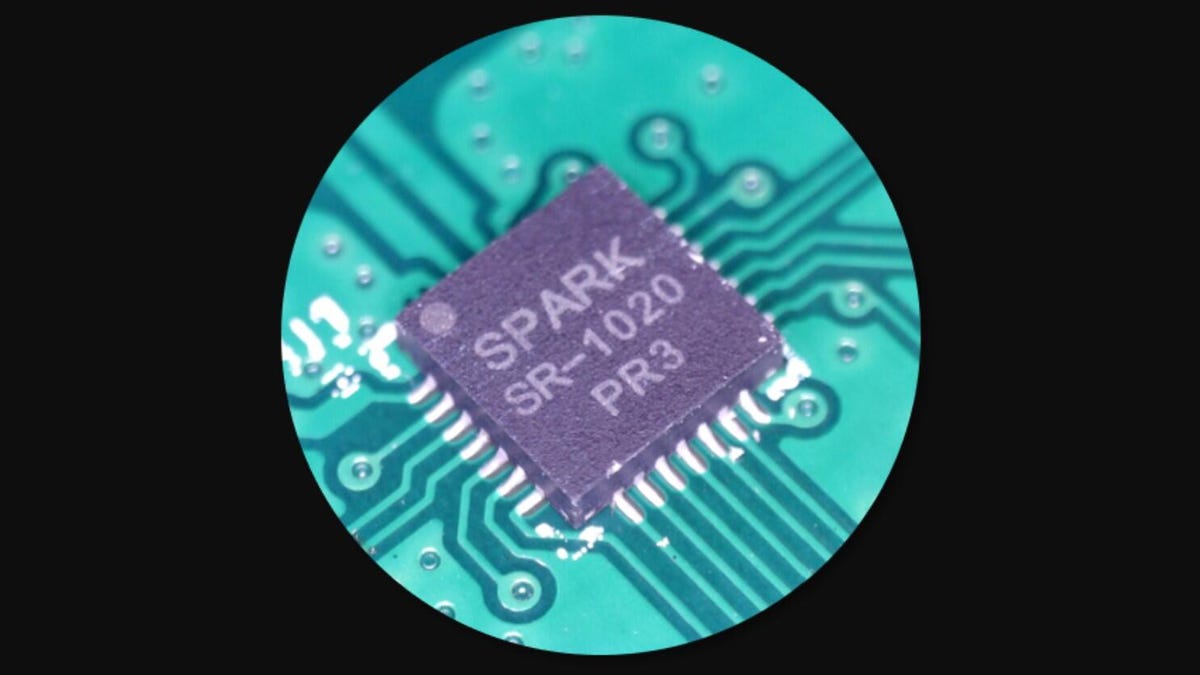Startup promises wireless gaming devices without Bluetooth lag
Spark Microsystems revamps an older technology called ultra wideband -- UWB -- for faster short-range wireless networks.

A Spark Microsystems short-range radio chip for ultra wideband (UWB) communications
There's a surge of interest in ultra wideband. The wireless standard, which was designed for data transfer, fizzled more than a decade ago but is now experiencing new life as a method for finding an object's precise position. UWB has already been built into the U1 chip that Apple added to its iPhone 11, and carmakers like BMW and Volkswagen could offer key fobs with UWB that unlock your vehicle when you get close.
Now Montreal-based Spark Microsystems wants to use UWB for its original intent -- it wants to see UWB in wireless gaming controllers, keyboards, headphones and mice. Gamers today often use wired peripherals that have minimal communication lag, but if Spark succeeds, the technology could challenge Bluetooth's future growth.
On Wednesday, Spark said its SR1000 radio chips will ship in the third quarter of 2020 and companies can test prototypes now. The chips will cost less than $1 apiece, said Fares Mubarak, who took over as Spark's chief executive in 2018.
Bluetooth has spread widely over the last two decades and is commonly used to connect earbuds speakers, headphones, mice and keyboards to phones and laptops. Using UWB will allow for faster data transfer, lower battery use and shorter communication delays that can hobble gaming, Spark's executives argue. They also tout it for virtual reality and augmented reality headsets and for internet of things devices.
Spark wants its chips to handle tasks that would benefit from a 10X improvement in performance and power consumption, like gaming peripherals, Mubarak said. "People are not going to switch for something that's only 20 percent better," he said.
The Bluetooth Special Interest Group, the industry consortium that develops the technology, didn't immediately comment.
Proprietary UWB tech today, standard tomorrow?
Today, Spark's technology is proprietary, meaning that anyone wanting to build it into a product has to buy its radio chips for both ends of the wireless connection. Once it's got products on the market, though, Spark hopes to standardize its version of UWB so others can join in. That standardization could come in 2022 or 2023, said Chief Technology Officer and co-founder Frederic Nabki, but selling working products today is. necessary first step.
"First we're going after market traction and credibility, then development partners and customers who can help us go to standardization of the next generation," Mubarak said.
UWB is a different variety of wireless communications compared with other standards like Bluetooth, Wi-Fi and Zigbee. Instead of using a relatively narrow slice of the radio spectrum, it spreads across a wide swath, sending data as very short pulses -- up to a billion of them, per second, which means each lasts only a nanosecond. To avoid disrupting other communications, UWB requires pulses to be very low power.
Because UWB pulses are so fleeting, they can be used for locating objects in space by precisely tracking the timing of those radio signals. That's why UWB is showing promise for location tracking technology. In principle, Spark's variety of UWB can be used for location, too, but it isn't in its products today.
Although phone makers aren't as likely to adopt UWB data-transfer technology if it requires a second chip, Spark does benefit when they build in UWB location technology. That's because the phone maker has made the important decision to add UWB-compatible antennas, which paves the way for other potential future UWB uses, Mubarak said. And in the longer run, as standards develop, Spark's approach could be used for location tracking, too.
Spark's UWB chips transfer data at as fast as 20 megabits per second. That's 10 times fast than Bluetooth 5 at 2Mbps, though still much slower than USB. At a 1Mbps connection, Spark's UWB link uses 40 times less battery power than Bluetooth.
Spark will sell two chips, the SR1010 that works uses radio spectrum from 3.1GHz to 6GHz and the SR1020, which uses 6GHz to 9.5GHz. Both are designed to work reliably despite Wi-Fi and other radio chatter, including Wi-FI's likely new expansion to the 6GHz band.

